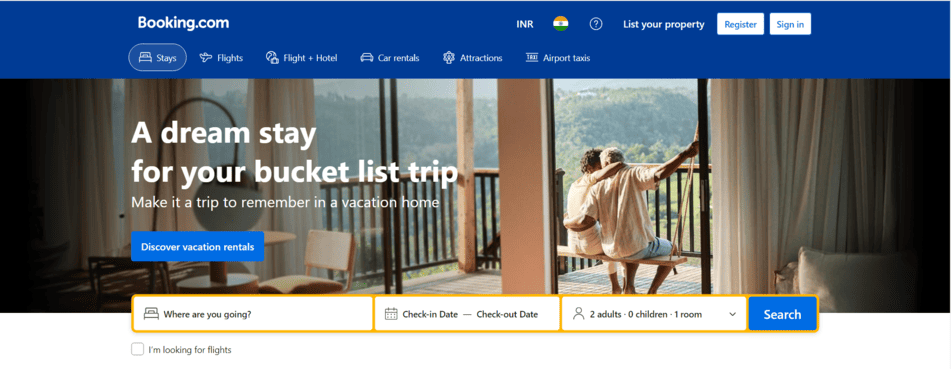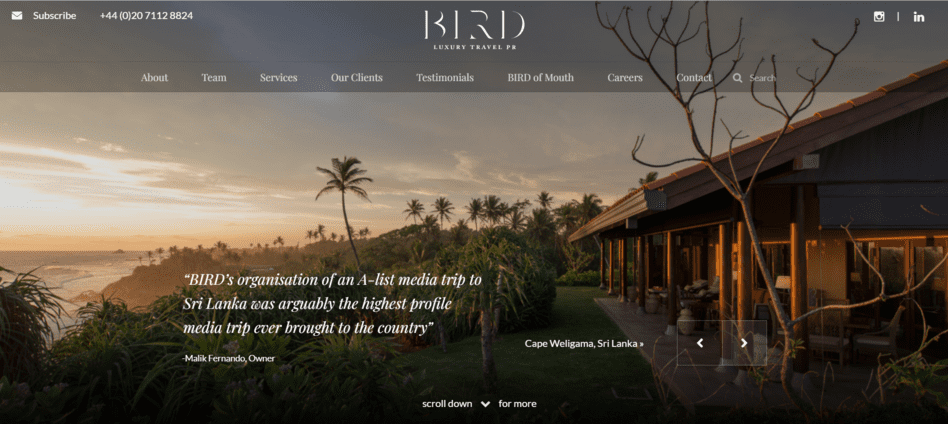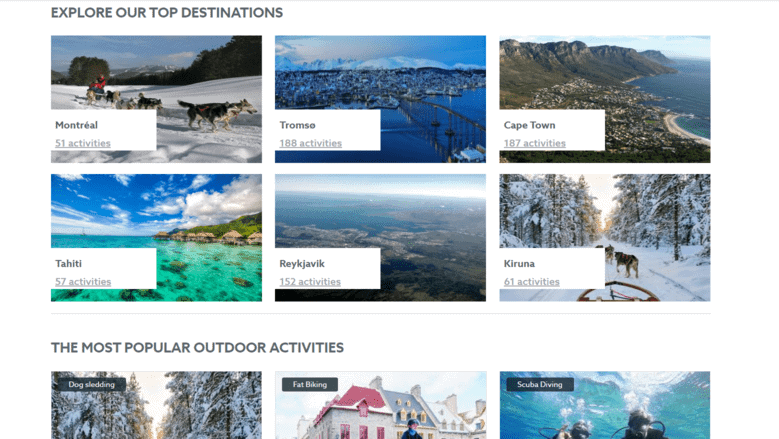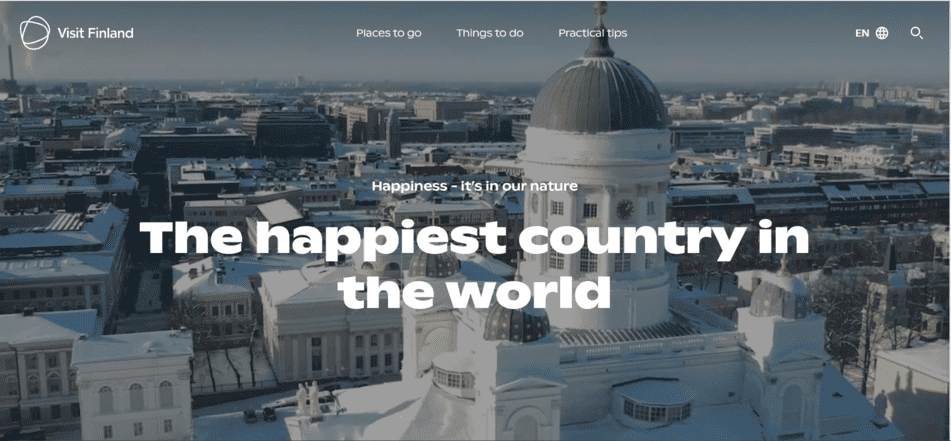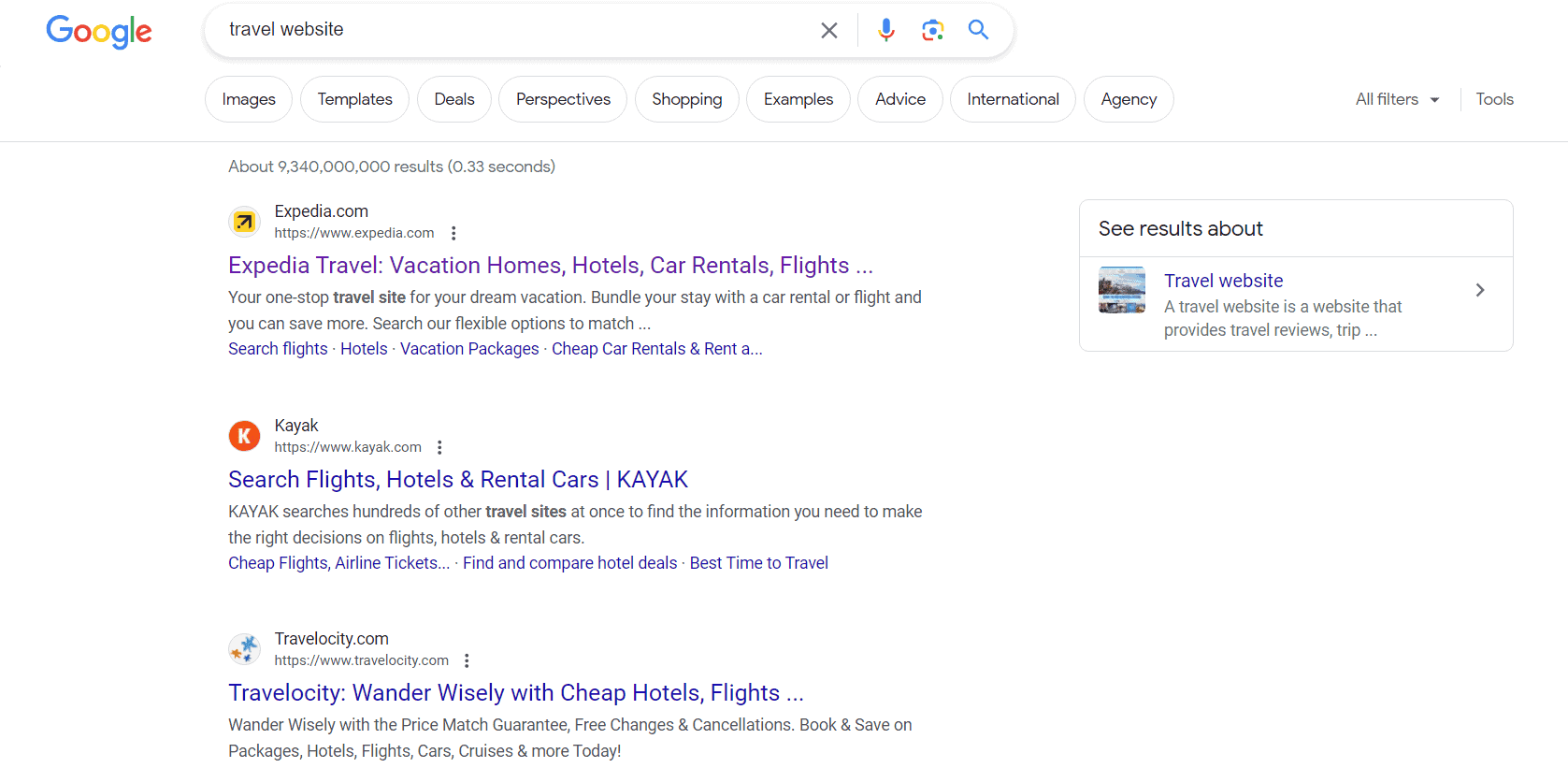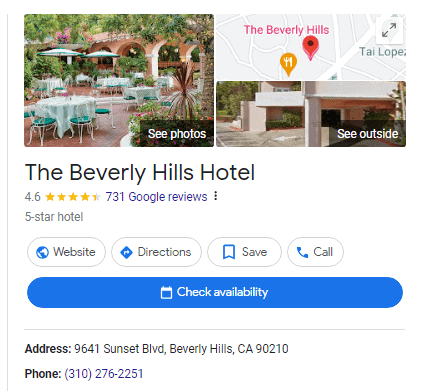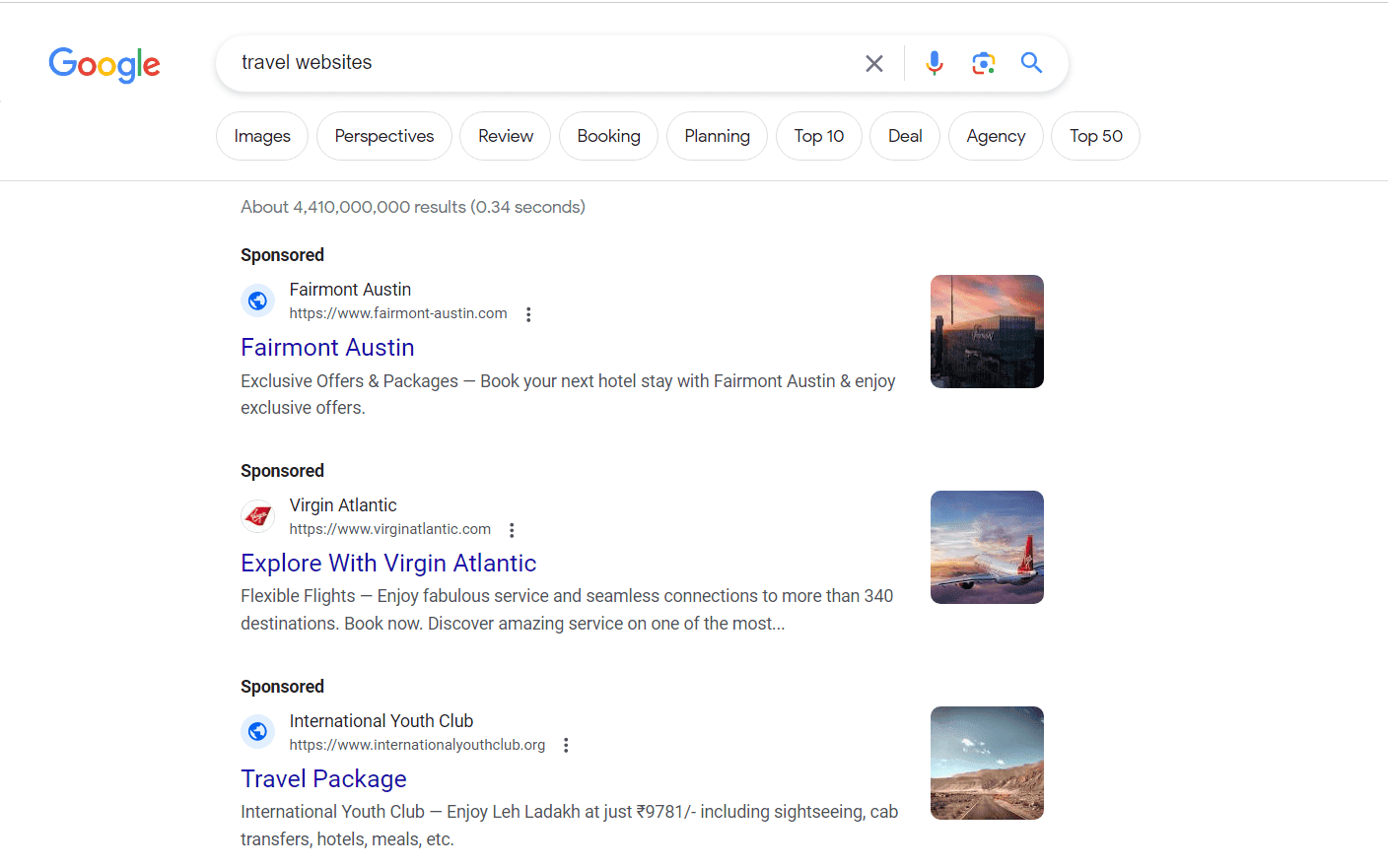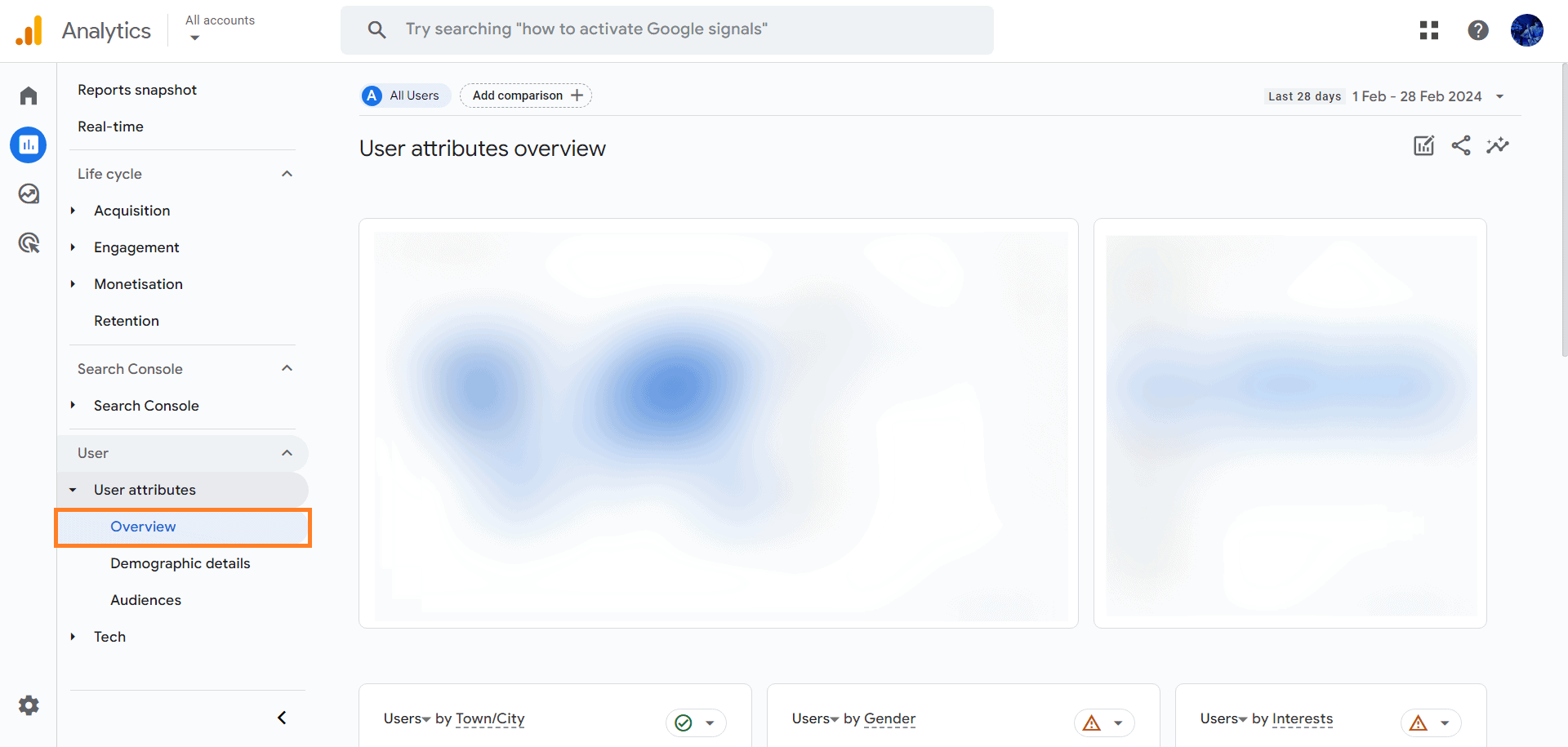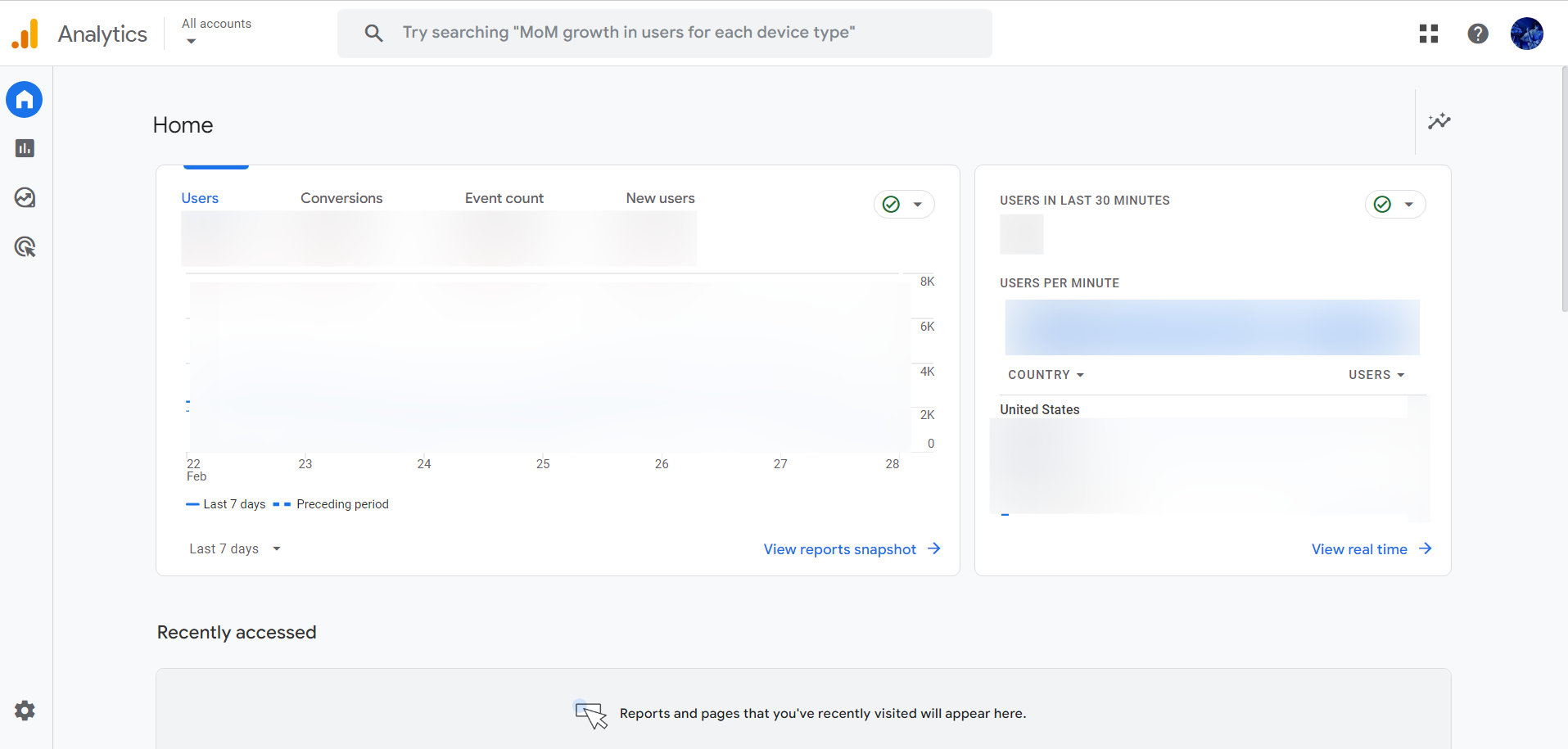Did you ever stumble upon a reel of someone lounging on a sunny beach in Hawaii and immediately wish to pack your bags and leave? Well, if you did, then you do realize how effective tourism marketing can be.
Let’s first understand what tourism marketing is.
Tourism marketing employs result-oriented strategies to promote a destination to an audience and sell tourism-related services like tour packages, flight tickets, car rentals, etc.
Like all effective marketing strategies, tourism marketing thrives when it puts the customer’s experience at its heart.
In this blog post, we will discuss tourism marketing strategies to help you get started and launch online campaigns that spark wanderlust.
Table of Contents
Significance Of Tourism Marketing
In 2023, the online travel market generated more than 2/3rds of the total revenue in the travel and tourism industry.
With over 83% of US adults preferring to make their bookings online, the digital space is THE place you should capitalize on.
There are various reasons why people prefer to plan their trips online, and understanding those reasons should bring us closer to creating a seamless user experience.
- Convenience: This should be a no-brainer. Almost every tour plan starts with a Google search, and users tend to look for videos and blogs that give them a no-nonsense guide on how to sketch out their blueprint for the trip and turn it into a practical reality. A mobile app presence and a smooth-functioning website are a must.
- Comparison: Customers can compare prices, services, and reviews online to select the plan that best meets their needs.
- Personalization: Who doesn’t like packages tailored to their needs?
- Efficiency: The efficiency of the buyer’s journey from consideration to purchase also relies on factors such as smooth website functionality, quick payment processing, and robust 24/7 support, ideally through a travel chatbot. Additionally, offering integrated services, like combining hotel booking with car rental, enhances the overall experience.
Booking.com is a fantastic example that covers all of these points. It is responsible for 25% of all hotel bookings worldwide. In 2022, its mobile app was the most downloaded in the travel agency category. It has become a one-stop destination for travel needs by expanding its services to include car rentals, flights, experiences, and even cruises!
Other similar examples include Expedia, Airbnb, and Hopper.
Branding in Tourism Marketing
Your brand is what people remember about your organization. It’s what your guests will gush about when they praise the beautiful experiences you played a part in creating.
For starters, there are two important brandings in tourism marketing that you should know:
- Tourism branding
- Destination branding
Tourism branding
Consider this: If your organization were a person, what would they be like? Are they adventurous and fun-loving? Do they put their family first? Or do they prefer to do things their way?
The brand is your business’s personality. It’s what makes your business stand out from the crowd in the tourism industry. And you need to be creative to do that.
Here’s a quick guide to branding in the travel and tourism industry.
In short, you have to:
- Create a strong visual identity through your brand design
- Weave a compelling brand story
- Develop your brand voice to attract your intended audience
BIRD is a luxury travel PR Agency based in the United Kingdom. Their homepage reflects their luxury brand through its sophisticated design and showcases of lavish locations like Cape Weligama in Sri Lanka and Marbella Club in Spain.
Destination branding
Now that we know what tourism branding is, let’s move on to destination branding. Successful tourism marketing strategies sell the destination first and services second. Tourism marketing for a specific destination is known as destination marketing.
Like your tourism brand, you should also consider the destination as a brand you must capture and promote.
Ask questions: What makes this city unique? What is its history and heritage? What do the locals think of the city? What fun activities does it offer? And present the answers in an informative and engaging way, with lots of pictures and videos!
This process in which you treat a destination as a brand is called destination or place branding.
Of course, you can also have a logo. Check out this colorful logo and branding of Visit Brasil, Brazil’s official tourism website.
The dazzling colors complement Brazil’s brand identity’s proud expression. They also reflect the country’s diverse ecosystems and multicultural identity.
The brand page also includes several sections about the brand’s history, inspiration, and legacy. Moreover, they have even added a video in which they continue with the theme of colors and describe Brazil as “the country of all colors.”
As Brazil’s branding shows, the core of destination branding is tapping into the city’s spirit and identity.
When you tap into that, you can promise your potential customers a holistic and unique travel experience full of exploration, adventure, and leisure instead of just a travel destination.
Before moving on to the next section, here’s an important tip: ensure your destination branding aligns with your tour brand. You can’t advertise yourself as an adventure brand and advertise a location for leisure, as you risk misaligning your customer expectations.
For example, here’s how Manawa, an adventure travel website, advertises its locations based on the number of activities available:
Travel and Tourism Digital Marketing
Travel and tourism digital marketing involves using digital resources to market a destination and tour-related services to a potential audience.
Think of Digital Marketing as a storytelling medium where you, as an author, can share your stories and measure their impact on people. And guess what? You also get to change the story according to the audience’s response. How cool is that?
The ultimate goal is to attract travelers to use your services to travel to the advertised destination.
Travel digital marketing includes a wide array of marketing strategies along with data collection, data analysis, and conversion strategies, including but not limited to:
- Website marketing
- Search engine marketing
- Travel content marketing
- Email marketing
Website marketing
First things first, you need to have a well-optimized website that reflects your brand and services. If you want to take advantage of the online traffic, your website should be at the heart of all your digital marketing services and efforts.
Having a website allows you to:
- Reach a wider audience
- Advertise your brand
- Provide comprehensive information on your itineraries
- Facilitate easy access to your services
Think of your website as your virtual storefront. Having great offers and services is great, but you might miss out if you don’t attract people with an efficient and eye-catching interface.
Here’s something to blow your mind: A good user interface on your website can boost the conversion rates by up to 200%. A smooth user experience design can boost these rates by 400% (source: Intechnic).
Customize your website to reflect your brand image and captivate your audiences.
Consider hiring a professional team specializing in web development and design in the travel industry to help you create your website. This will ensure your website looks good and is optimized for performance, SEO, and user experience.
You can read more about starting your travel website here.
Read on to learn about website optimization.
Website optimization
When something’s meant to be, everything magically falls into place. But sometimes, poor and clunky site optimization stands in your customer’s way while planning the perfect trip.
And let’s not even talk about the websites that are practically hostile with their slow load speed, complex jumbled-up interface, and ten different pop-ups that redirect to a new tab with every click.
A good user experience must be a topmost priority to win over your customers.
Here is a list of features you should prioritize on your travel website:
- Engaging homepage
- Intuitive navigation
- Fast load speed
- SEO optimization
- Easy search filters
- Predictive search
- High-quality photos and videos
- Clear information on services
- Blog
- Destination pages
- Google Map integration
- User-friendly booking system
- Mobile responsive design
- Contact information
- Customer reviews and testimonials
- Multi-language Support
- Social media integration
- Newsletters
- Customer care and chatbots
- Call-to-action
- FAQs
Let’s check out Visit Finland, which is an example of a well-optimized travel website. Also, note how they celebrate being the happiest country in the world for the seventh time in a row.
The background of this website is a beautiful montage of several silent videos of sights like the Northern Lights and snow-capped pine trees and activities like skiing and sledding to capture the essence of the country.
The interface is very clean, with the top menu providing informative content on destinations, activities, and tips, along with an accessible search feature and multi-language options.
Here’s a fun activity: check out the Visit Finland website and analyze how many features it has from our list of travel website features!
Read also: How To Start A Travel Agency From Scratch In 6 Steps
Search Engine Marketing (SEM)
Okay, let’s assume your website is well-optimized and live. Now what?
Now, you should build an effective tourism marketing strategy that ties in with your content marketing efforts.
Your objective is to increase traffic to your website, which you can do with Search Engine Marketing, one of the best tourism marketing strategies.
Search Engine Marketing, or simply Search Marketing, is a digital marketing strategy in which you maximize visitors to your website by using SEO’s organic reach and paid advertising’s targeted push.
Let’s briefly discuss how you can get more traffic through organic and paid strategies.
Organic traffic strategies
Organic traffic, as the name suggests, refers to the visitors that land on your tourism website organically, i.e. without using ads or any form of sponsored or promoted content.
To gain organic traffic, you need to rank high on the Search Engine Result Pages (SERPs) of search engines like Google, Yahoo, and Bing. You can do this by optimizing your website with the best SEO practices.
Search Engine Optimization (SEO)
SEO is how you make sure people find your website in search engine results for queries relevant to your website and services.
For example, when I Google “travel websites,” this is what I get:
Notice how none of the websites are sponsored to appear on the top, which means that Expedia, Kayak, and Travelocity have integrated their website with best SEO practices to rank at the top of Google search.
It goes without saying that the higher your website appears in search results, the more visitors it will generate. A comprehensive SEO strategy is one of the most cost-effective ways to rank your website high in search results.
Let’s quickly discuss what SEO strategy includes and what resources you can use to implement it:
1. SEO audit
An SEO audit will help you analyze the current state of your website SEO.
You can audit your travel website using Google Search Console or Semrush’s Site Audit.
2. Keyword optimization
When you sprinkle your targeted keywords around your website and blogs to gain more organic traffic, it’s called keyword optimization.
Ideally, you should target long-tail keywords which are phrases consisting of three to five words for your travel website. This approach ensures that your website pops up to users for whom your services are more relevant.
For example, if you offer budget, family-friendly hotels in Toronto, you will benefit more by targeting long-tail keywords like “affordable family hotels Toronto” or “cheap hotels Toronto” than, say, a broad and highly competitive keyword like “hotels.”
You can use Semrush’s Keyword Magic Tool or Moz’s Keyword Explorer to develop keyword suggestions.
3. Local SEO
You must optimize your website for local search if you offer a location-specific travel service. Doing this ensures that your website is easily discoverable by users who search for travel services in your area.
An essential aspect of local SEO is creating a Google Business Profile. This profile lets you manage your business’s online presence in Google Search and provides accurate information about your services, such as location, timings, reviews, etc.
For example, here’s a snippet of the Google Business Profile of The Beverly Hills Hotel. You can access the hotel’s location, phone number, website, reviews, and other details from one place.
4. Uploading quality content
This is an excellent method of boosting your SEO efforts. Read more on this topic in the travel content marketing section.
5. Optimizing images and videos
Large-sized images can slow down your tourism website’s load speed, which has detrimental effects on user experience. Similarly, if you directly host a video on your website, its load speed decreases further.
Compress your images and host your videos on platforms like YouTube to ensure a fast website load speed. You can check your website’s load speed with Google’s PageSpeed Insights.
6. Mobile optimization
Since 58% of global traffic comes from Mobile, Google now follows a mobile-first indexing approach. This means you must also ensure your website functions smoothly on mobile devices.
You can use Google’s Mobile-Friendly Test tool to check if your website is optimized for mobile.
7. Schema markup
For the uninitiated, this fearful-sounding term refers to a code that is added to your website that helps search engines generate rich results like this:
Learn how to add Schema Markup to your website here.
8. Internal linking
When you include links within your site that lead to other pages on the same site, it’s called internal linking.
This method helps your users get relevant information, distributes the SEO value, and increases search engine visibility of pages across your website.
You can use Screaming Frog SEO Spider to analyze your site’s internal linking structure and make improvements accordingly.
9. Backlinks
Backlinks are external links from other websites that direct visitors to your website. Getting backlinks from trusted sources conveys to search engines that your content is also trusted. This positively affects your site’s ranking in search results.
To harness the full power of backlinks, you need to run a backlink analysis to determine the quality of your current backlinks and other potential backlink opportunities. Ahrefs’s Site Explorer and Semrush’s Backlink Analytics can help you with this.
Paid traffic strategies
Now that you have some idea about how to direct organic traffic to your travel website, let’s hop onto paid traffic strategies!
Simply put, paid traffic refers to the visitors to your website that you acquire by paying for advertising.
Organic SEO is effective but a slow process that takes a lot of effort. Paid Ads, however, can reach your targeted customers almost as soon as your ad is approved and published.
There are several types of paid ads; let us discuss some of them:
1. Paid search results
Paid Search Results appear at the top of SERP like this:
Paid search results are a very effective marketing method as it helps you get a lot of targeted traffic to your website. This form of advertising is also called Pay-Per-Click (PPC) advertising because you only need to pay when a user actually clicks on your ad.
Google Ads is the most popular PPC platform, and it can provide unparalleled reach thanks to Google’s search engine dominance.
Google also provides extensive tutorials on how to use Google Ads.
2. Social media ads
Social Media Ads use Social Networking sites such as Facebook, Instagram, YouTube, etc, to deliver paid ads to a targetted audience.
Depending on user behavior on the platform, these ads can be in various formats, such as pictures, carousels, reels, videos, etc. They are catchy and crisp to hook the audience in.
You should work on a comprehensive strategy that includes finding where your target audience spends the most time and creating cross-platform campaigns to reel the customers into your website.
3. Display ads
Display ads are graphical advertisements that can appear on websites, social media platforms, and mobile apps.
You can capture travelers’ attention and lead them to your website with targeted creative advertisements, promotions, and compelling calls to action (CTA) with the help of display ads.
These ads can be created in various formats, such as banners, videos, animated, or interactive ads, each offering a unique way to capture your audience’s attention.
4. Retargeting
People can be forgetful. They might visit your website and browse offers and packages but forget to finalize their purchase. At this point, retargeting ads come in handy.
With retargeting ads, you can send personalized messages or special offers, such as discounted rates or limited-time deals, to entice the traveler back to your website and get that booking done.
For instance, if a visitor was looking at a weekend getaway package but didn’t proceed to checkout, you could retarget them with an ad highlighting an exclusive 10% off on their next booking or perhaps offer an additional day at no extra cost. Such personalized incentives make the offer hard to resist and can significantly increase the likelihood of conversion.
Read also: Automation in Restaurants: How to Streamline Ordering
Travel content marketing
Travel content marketing is a beast on its own. This method involves creating and distributing different kinds of content about your destination, like blogs, social media posts, videos, etc.
Travel isn’t just about escaping your daily life; it can also be a life-changing experience. What better way to convey this message than by creating rich stories through your content?
The aim is to attract and captivate your audiences by giving them relevant information and services and converting them into valuable customers. After all, when it comes to the internet, what catches the eye isn’t just content; it’s the lure that turns casual clicks into sales and engagement.
Highlight what is unique about the destination and how a potential customer would find value in what you’re promoting.
Create content that educates them about different cultures and inspires them to travel and explore the destination. You can also use ads with appealing visuals to pique the audience’s interest and lead them to your online channels.
Here are a few types of content marketing methods that you can utilize to market your destination:
Blog marketing
Blogging is one of the most traditional and effective tourism marketing tools. Given their longer format, you don’t have to sacrifice details like you would have to in a social media post.
Blogs can be used to give travelers quality information, customer feedback, and package information.
What’s more, blogs can made more visually appealing by adding pictures and videos from your social media and setting the theme to match your brand tone.
Check out the blog of Backpacking Tours, a travel website that provides adventurous backpacking experiences and volunteer opportunities across Asia.
Notice how their blog offers informative content about their locations, packages, and customer reviews. It also provides essential details about visas and vaccinations, ensuring travelers are well-prepared for their adventures.
Video marketing
Video marketing involves creating video content to promote your destination on websites, social media channels, or video publishing platforms.
Video marketing can be much more engaging, as it’s more appealing to the senses.
Although videos require more time and resources than blogs, they are a far more effective way to capture your audience’s attention.
Videos can also be repurposed and posted on different platforms. And considering how some of the most popular social media platforms prioritize short-form video content, now is a great time to hop onto the video marketing trend.
Many travel websites like Incredible India even use videos as a background for their website!
Social media marketing
In this day and age, this is perhaps the most relevant and effective way to reach out to a wider audience.
Even though there are many social media platforms to choose from, we suggest you focus your efforts on just a couple without stretching yourself thin. After all, a thriving Facebook page is better than an abandoned Pinterest board.
Tapping into social media to promote your brand can open up a treasure trove of digital marketing opportunities. You can modify your content according to the platform and audience.
Speaking of your audience, make sure to have fun interactions with them through comments, messages and even memes!
Short-form videos, images, sponsored ads, user-generated content, and influencer collaborations (influencer marketing) are just some of the ways you can harness social media to create awareness and run campaigns for your brand.
What’s better, you can even create social media trends and hashtags and encourage your customers to tag you, just like the Hawaii tourism department did with their #lethawaiihappen campaign.
Email marketing
Email marketing is the use of emails to market your business and services. This is where you can personalize your content and win over your customers with targeted emails.
Email marketing is especially useful for small business owners as it returns a lucrative return on investment.
Send your customers personalized emails based on their past travel preferences, wish them on special occasions with special discounts, or send them travel packages tailored to their interests. The opportunities are endless!
If you do it right, you can create a relationship with your customers where they look forward to receiving your emails. Newsletters are a great way to do that and hook your audience in with informative content like hidden travel locations, festivals around the world, etc.
Read also: The Eight Best CRM Software for Travel Agencies
Leveraging Technology
The Internet is full of people trying to leverage its power to attract an audience. To stand out, you should constantly update yourself and your brand.
The key to success is staying in the loop with technological innovations and figuring out how to include them in your tourism marketing efforts.
Artificial Intelligence, Augmented Reality, and Virtual Reality have all been in buzz for quite some time. With new products like Apple Vision Pro and the innovations of the AI boom we have been witnessing, the opportunities to integrate them into your marketing efforts are limitless.
Let us see how we can utilize it to our advantage and provide a unique experience to our potential customers:
Artificial Intelligence (AI)
AI is rapidly revolutionizing our world, and businesses eagerly embrace this transformation to stay ahead.
You can use AI to generate personalized tour package recommendations, provide 24/7 service through travel chatbots and virtual assistants, and automate manual tasks, among other things.
Virtual Reality (VR)
Who doesn’t like trying on a product to see if they like it? Now, you can provide your target audience with virtual reality tours of destinations so they can gain interactive and immersive experiences before their travel.
One of the most famous examples of VR utilization is the whimsical “Sheep View 360°” campaign of the Faroe Islands. This remote Danish archipelago has more sheep than people, which befits its name (which literally means sheep islands).
Google Street View has proven very effective in promoting tourism. Back in 2016, when the people of the Faroe Islands got tired of waiting for Google Street View to come and take the survey of their land, the marketing department took the task upon themselves. They attached 360° cameras to their sheep and let them wander freely on the islands.
The result was a unique panoramic sheep view of the gorgeous island landscape.
This ingenious VR campaign was combined with Social Media Campaigns #WeWantGoogleStreetView and #VisitFaroeIslands. It proved very successful, and Google praised it as “shear brilliance.”
Augmented Reality (AR)
Augmented Reality blends the real world with virtual elements. It is a very innovative way to provide additional information to tourists when they scan the surroundings with their smartphones. From interactive maps and virtual reconstruction of historical sites to AR Gamification, the potential of this technology is limitless.
Here is an example of AR integration in a guided tour of Singapore:
Determining Target Audience
Before starting, you will need to be clear on what is your goal. If it’s attracting more tourists, what kind of tourists do you want, local or international? What are their travel preferences, railways, or flights? What age group do they belong to? What is their marital status?
Such questions will help you understand your target audience, their preferences, and their concerns. This will help you create a buyer’s persona, a semi-fictional representation of a potential buyer created using actual data.
Buyer’s persona, in turn, helps create effective and relevant marketing campaigns for an interested audience.
The benefit of doing this is that instead of blasting your marketing efforts to a large number of people who may or may not be interested in making a purchase, you are precisely targeting your efforts on potential customers.
Okay, so now you understand that you need to know about your potential audience and their interests to create a buyer’s persona. But how do you collect this information?
Enter web analytics tools.
That sounds technical. But what are web analytics tools?
Web analytics tools help you analyze the behavior of people who visit your website. They also track user engagement, get insights into audience demographics, measure conversion rates, and assess the effectiveness of marketing campaigns, among a host of other things.
Using Google Analytics to know the customer demographics
Google provides the most popular and widely used web analytics tool called Google Analytics. Here’s a quick guide on how to create a Google Analytics 4 account.
After you set up Google Analytics on your website, you can view the Google Analytics dashboard, which provides key metrics like website traffic, conversions, and user engagement.
To gain insights into your demographics, make sure you enable demographics and interest reports.
Then, go to the main menu, click Reports, and navigate to User > User Attributes > Overview.
This gives you an overview of your website visitors’ demographics, such as location, age, gender, language, and interests.
You can also view the most searched queries that lead them to your website by clicking on Search Console > Queries.
Once you get these details, you can adjust your customer acquisition strategies and marketing messages to attract the likely customers.
Suppose you observe that men from the USA aged between 18 and 24 and are interested in technology visit your website most often. You also find that the most common search query that leads them to your website is Japan.
Now, you can tailor some marketing messages to highlight Japan-related content or technology products that resonate with this specific audience segment.
Insights are readily available on social media platforms like Facebook and Instagram.
After collecting user data, you should store it in a database. This is where a Customer Relationship Manager (CRM) will come in handy. A CRM software helps you store and manage your customer relationships all in one place.
You can try EngageBay’s CRM to help you with this:
Measuring the Performance of Your Tourism Campaigns
This is where we get into the analytical side of Tourism Marketing. Fear not; we will break it down as simply as we can.
First, you should know what Key Performance Indicators (KPIs) are. KPIs are measurable metrics that tell you about the performance of your specific marketing efforts. Based on these metrics, you can understand which marketing efforts are yielding conversions so that you can tweak your campaigns accordingly.
When it comes to measuring the performance of your tourism marketing campaigns, you should measure the hard and soft metrics of KPIs.
Hard metrics, such as conversion-based sales and revenue metrics, directly measure your campaign’s success by tracking bookings and revenue generated.
The goal of any tourism campaign is to generate more revenue than it costs (duh!). The Return On Investment (ROI) should be a major KPI.
Then comes the soft metrics, which measure the performance of your digital marketing efforts. Soft metrics measure brand perception and recall, customer satisfaction and retention, and other factors like click-through rate (CTR), website traffic, and social media engagement.
Setting practical KPIs and monitoring the impact of your strategies allows you to cut the fluff and determine where the most customer conversions are coming from. Make sure to integrate your website with analytic tools such as Google Analytics, social media insights, and CRM systems to get access to comprehensive data.
Keep updating your strategies according to your findings, and make sure you also note customer reviews.
Read also: Travel Agency Marketing — Strategies for Success in the Digital World
Sustainable and Responsible Tourism
The popularity of sustainable and responsible tourism is growing as people become more aware of the impact of their actions on the environment. This mindful and responsible tourism seeks to benefit the local small businesses and communities and conserve biodiversity.
It is a shift from mass tourism models that lead to overcrowded destinations, increased pollution, and resource depletion.
With its strict entry requirements and “high value, low impact” tourism model, Bhutan is a prime example of sustainable tourism.
You can include sustainable tourism practices in your business model by:
- Developing sustainable branding
- Launching social media campaigns that provide eco-friendly travel tips and highlight local businesses and cultures.
- Committing to reuse and recycling.
- Partner with businesses that reject single-use plastic.
- Promote packages focusing on mindful interaction with the local culture and environment, etc.
Read also: 20 Hotel Marketing Ideas To Thrive In The Digital Age
Conclusion
We hope you feel prepared to start an eye-catching marketing campaign! Always remember to put the customer experience and needs at the center stage. You can easily connect with your potential audiences with the right strategies and creative campaigns. Wishing you all the best for your future endeavors! Happy marketing!
EngageBay is an all-in-one marketing, sales, and customer support software for small businesses, startups, and solopreneurs. You get email marketing, marketing automation, email templates, landing pages, personalization, sales pipelines, and more.
Sign up with EngageBay for free, or book a demo with our experts.

